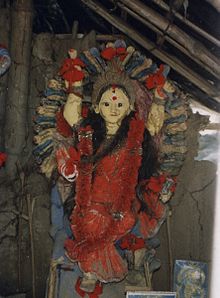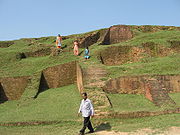- Chand Sadagar
-
Chand Sadagar, (Bengali: চাঁদ সওদাগর), (the surname is also spelt Saudagar), was a rich and powerful merchant of Champak Nagar in ancient India.[1] Bipradas Pipilai gave an account in his Manasamangal about the merchant ship of the trader Chand Saudagar proceeding to the sea, passing through Saptagram and Tribeni, the tri junction of the Ganges, Saraswati and Yamuna.[2] His life is a story of how he was forced to be converted to become a worshipper of Manasa, the goddess of snakes.[1]
Contents
Mythology
According to Hindu mythology, Chand Sadagar was an ardent devotee of Shiva but Manasa had set her mind on making him a devotee. She tried all the tricks to force Chand Sadagar to change his mind but he was equally determined and protected himself with the mantras or mystic words he had received from Shiva. However, when Manasa appeared to him as a beautiful woman, he let her know his secret. Thereafter, he lost his supernatural powers that came with the mystic words. He then took the help of Sankara, whose capabilities were more than even his when he had full powers, but Manasa killed him and made Chand Sadagar helpless again.[1]
When Chand Sadagar still refused to be intimidated into worshipping Manasa, she started sending serpents that killed all his six sons. His trading interests collapsed as he did not have the heart to look after them properly. Even in the midst of such adversity his determination revived and he set out on a sea voyage to rebuild his business. After a successful business tour he set sail for home, his ship laden with treasure. Manasa launched a storm, and although Chand Sadagar initially survived with support from Durga, she was later asked to withdraw by Shiva on a request from Manasa. Once that happened Chand Sadagar’s ship was wrecked, but Manasa swept him ashore at a place where an old friend Chadraketu lived.[1]
Chandraketu tried his best to bring him round to the goddess Manasa but Chand Sadagar steadfastly refused. He became a beggar and lost everything but still worshipped only Shiva and Durga, refusing to bow to Manasa, who felt that she could never win over Chand Sadagar on her own and took the help of two friends in heaven – two Apsaras. They agreed to be born on earth, one as Chand Sadagar’s son and the other as daughter of Saha, a business associate of Chand Sadagar.[1]
Lakshmindara and Behula
Having returned to Champak Nagar, Chand Sadagar managed to rebuild his life. A son was born to him. They named the boy Lakshmindara. At around the same time Saha’s wife gave birth to a daughter, whom they named Behula. Both the children grew up together and were a perfect made-for-each-other, but when their horoscopes were tallied, it was predicted that Lakshmindara would die of snake-bite on the wedding night. However, as both the children were already devotees of Manasa and were so well matched that the marriage went through. Chand Sadagar took extra precaution in building a new bridal chamber that snakes could not penetrate.[1]
In spite of all the precautions, Manasa had her way. One of the snakes, sent by her, killed Lakshmindara. It was the custom that anyone who died of snake-bite was not cremated in the usual way but was allowed to float on a raft down the river, with the hope that the person could miraculously come back to life. Behula insisted on accompanying her dead husband on the raft ignoring all the pleas of others not to do so. They sailed for six months, passing village after village, the corpse began to decompose, the villagers thought of her as a mad person. She kept on praying to Manasa. All that the latter did was to protect the raft from sinking.[1]
The raft arrived at the place where Neta, Manasa’s foster mother stayed. She worked as a washer woman and was on the river bank when the raft touched land. Hearing Behula’s perpetual prayers to Manasa, she decided to take her to Manasa. Using her supernatural powers, Neta whisked Behula and the dead Lakshmindara to heaven. Manasa said, “You deserve to have him back, but this can only be done if you promise to convert your father-in-law to my worship.”[1]
“I will,” said Behula, and immediately life started to stir the corpse of her dead husband. His decayed flesh healed, he opened his eyes. He smiled at Behula.[1]
With Neta as their guide they returned to earth. Behula met her mother-in-law and narrated all that happened. She went and told Chand Sadagar about it. He could not say no to worshipping Manasa.[1]
Chand Sadagar worshipped Manasa on the eleventh day of the waning moon every month. He could not forgive the goddess for all the suffering he had to go through. He offered her flowers with the left hand and turned his face away from her image. Manasa did not hold anything against him for that. From then on Chand Sadagar and his family lived in peace and prosperity. Chand Sadagar’s status and prestige ensured that the worship of Manasa became generally accepted and respectable.[1]
==Champak Nagar== Bogra
Champak Nagar is placed by some in Anga.[3] The ruins unearthed in the village Gokul, 3 km to the south of the Mahasthangarh citadel, 9 km north of Bogra, off the Bogra-Rangpur road, connected by a narrow motorable road about 1 km, is known as Gokul Medh, but is locally called Behular Basar Ghar or Lakshmindaraer Medh. Excavations in 1934-36 revealed a terraced podium with 172 rectangular blind cells. It is dated 6th-7th century. Local mythology associates it with legendary Lakshmindara-Behula. In the Mahasthangarh area in village Chenghispur, 700 m west of the north-west corner of the citadel has revealed remains of a temple. The mound is named after Sanoka, wife of Chand Sadagar. The Karatoya once a mighty river but now a small stream flows nearby.[4]
Dhubri in Assam, further north of Bogra, is associated as the place where Neta, foster mother of Manasa, lived and worked as a washerwoman. A temple at Howrah, a Kolkata neighbourhood, is believed to have been built by Chand Sadagar.
Between the citadel and the eastern embankment at Gaur, a ruined structure, is claimed to be the house of Chand Sadagar.[5]
Theatre-Cinema
In 1927, Manmatha Roy wrote the mythological play Chand Saudagar, in which he portrayed the rebellious Bengali character.[6]
In 1934, Prafulla Roy directed a film Chand Saudagar in which Dhiraj Bhattacharya played the role of Lakshmindara, Ahindra Choudhury that of Chand Sadagar, Devbala of Manasa, Sefalika Devi of Behula, Jahar Ganguli of Kalu Sardar, Indubala of a singer, Niharbala of Neta Dhobani, Padmabati of Sanaka and Usharani of Amala. It was written by Manmatha Roy. Film editing was by Akhil Neogi.[7][8]
In 2010, Star Jalsha create a serial "Behula".
References
- ^ a b c d e f g h i j k Radice, William, Myths and Legends of India, 2001, p. 130-138, Viking Penguin Books Ltd., ISBN 9780670049370
- ^ Roy, Niharranjan, Bangalir Itihas, Adi Parba, (Bengali), first published 1972, reprint 2005, p. 75, Dey’s Publishing, 13 Bankim Chatterjee Street, Kolkata, ISBN 81-7079-270-3
- ^ "Bihula, the legendary lady of Anga/ Ang Desh". rediff.com, 1 August 2005. http://bihula.rediffblogs.com/2005_31_07_bihula_archive.html. Retrieved 2007-12-12.
- ^ Hossain, Md. Mosharraf, Mahasthan: Anecdote to History, 2006, pp. 56-65, Dibyaprakash, 38/2 ka Bangla Bazar, Dhaka, ISBN 984 483
- ^ Ray, Aniruddha. "Gaur". Banglapedia. Asiatic Society of Bangladesh. http://banglapedia.org/HT/G_0051.HTM. Retrieved 2007-12-12.
- ^ Ahsan, Nazmul. "Manmatha Roy". Banglapedia. Asiatic Society of Bangladesh. http://banglapedia.search.com.bd/HT/R_0244.htm. Retrieved 2007-12-12.
- ^ "Chand Saudagar". chakpak.com. http://www.chakpak.com/movie/chand-saudagar/cast/15757. Retrieved 2007-12-12.
- ^ "Chand Saudagar". citwf.com. http://www.citwf.com/film57950.htm. Retrieved 2007-12-12.
Categories:- People in Hindu mythology
- History of Bengal
Wikimedia Foundation. 2010.


